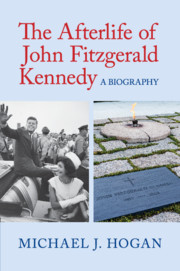Book contents
- Frontmatter
- Dedication
- Contents
- Acknowledgments
- List of Abbreviations
- 1 The Afterlife of John Fitzgerald Kennedy: An Introduction
- 2 All the World's a Stage: Constructing Kennedy
- 3 From History to Memory: Assassination and the Making of a Sacred Symbol
- 4 Ritual and Remembrance: Cultural Trauma, Collective Memory, and the Funeral of John Fitzgerald Kennedy
- 5 In Death There Is Life: Monuments of Paper and Pen
- 6 In Death There Is Life: Monuments of Glass, Steel, and Stone
- 7 The Memory Wars: Contesting Kennedy
- 8 Gone but Not Forgotten: History, Memory, and Nostalgia
- Notes
- Selected Bibliography
- Index
7 - The Memory Wars: Contesting Kennedy
Published online by Cambridge University Press: 23 March 2017
- Frontmatter
- Dedication
- Contents
- Acknowledgments
- List of Abbreviations
- 1 The Afterlife of John Fitzgerald Kennedy: An Introduction
- 2 All the World's a Stage: Constructing Kennedy
- 3 From History to Memory: Assassination and the Making of a Sacred Symbol
- 4 Ritual and Remembrance: Cultural Trauma, Collective Memory, and the Funeral of John Fitzgerald Kennedy
- 5 In Death There Is Life: Monuments of Paper and Pen
- 6 In Death There Is Life: Monuments of Glass, Steel, and Stone
- 7 The Memory Wars: Contesting Kennedy
- 8 Gone but Not Forgotten: History, Memory, and Nostalgia
- Notes
- Selected Bibliography
- Index
Summary
Neither Jacqueline Kennedy nor Carl Warneke had thought of Arlington National Cemetery as an appropriate setting for a traditional work of monumental architecture. The site was naturally monumental in itself, and plans quickly formed behind the National Cultural Center as the federal government's major memorial to the president. Besides, the former first lady had monumental plans for another location, which the president himself had selected, if not necessarily for this purpose. Kennedy had decided to deposit his papers in a presidential library to be built on the campus of Harvard University. He and Warneke, another Harvard graduate, had actually searched the campus for an appropriate location shortly before the president was assassinated. After that, final decisions rested with the Kennedy family, especially Jacqueline Kennedy, who was determined to honor her husband's wishes, though in a fashion that joined his plans to her own dreamy vision of the man she wanted everyone to remember.
Several of Kennedy's predecessors had established presidential libraries, starting with Franklin Roosevelt, who donated his Hyde Park home for that purpose. Truman, Eisenhower, and Hoover followed with modest ventures that included an archive for the benefit of scholars and a museum of presidential artifacts, mostly for the benefit of tourists. Thanks to Jacqueline Kennedy, however, the Kennedy Library and Museum became something more – an impressive work of art in its own right and a grand monument to her husband's memory. Although her vision came to fruition after President Johnson had opened his own, Texas-sized structure on the campus of the University of Texas at Austin, planning for the Kennedy Library had begun much earlier and clearly inspired Johnson and subsequent presidents, many of whom tried to outdo the others with expensive monuments to themselves and their administrations. Another example of the heritage boom, these American “pyramids,” as one critic has called them, often presented their subjects as heroic figures in American history, occasionally at the expense of history itself. They did so not only in the museums they sponsored but also in the records they archived and sometimes hid from public view. In both regards, the Kennedy Library and Museum set the standard for much of what followed.
As a site of memory, the Kennedy Library and Museum revealed in its architecture the same themes that Jacqueline Kennedy had captured so successfully in her design for the president's gravesite.
- Type
- Chapter
- Information
- The Afterlife of John Fitzgerald KennedyA Biography, pp. 156 - 196Publisher: Cambridge University PressPrint publication year: 2017

